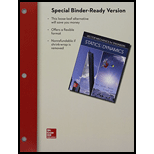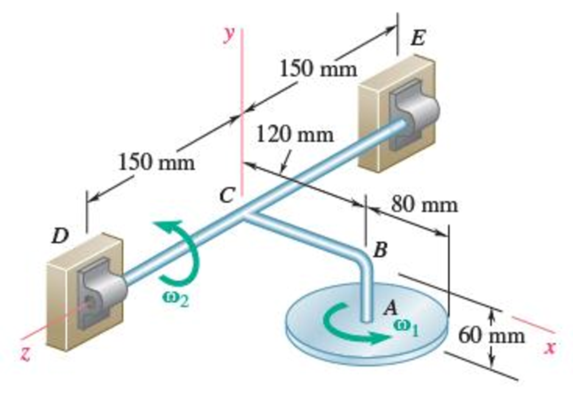
Concept explainers
A 2.5-kg homogeneous disk of radius 80 mm rotates with an angular velocity ω1 with respect to arm ABC, which is welded to a shaft DCE rotating as shown at the constant rate ω2 = 12 rad/s. Friction in the bearing at A causes ω1 to decrease at the rate of 15 rad/s2. Determine the dynamic reactions at D and E at a time when ω1 has decreased to 50 rad/s.

Fig. P18.103 and P18.104
The dynamic reactions at D and E at a time when
Answer to Problem 18.103P
The dynamic reactions at Dat a time when
The dynamic reactions at Eat a time when
Explanation of Solution
Given information:
The mass (m) of the disk is 2.5kg.
The radius (r) of the disk Ais 80 mm.
The angular velocity
The decreasing acceleration
Calculation:
The angular velocity
Write the equation of angular velocity of disk A
Write the equation of angular velocity
Find the equation of angular velocity
Substitute 0 for
Find the equation of angular momentum about A
Here,
Substitute 0 for
Find the rate of change of angular momentum
Here,
Write the equation of vector form of angular velocity
Write the equation of the rate of change of angular momentum about A
Substitute
Write the equation mass moment of inertia
Write the equation mass moment of inertia
Substitute
Find the position vector
Here, b is the horizontal distance and c is the vertical distance.
Write the equation of velocity
Substitute
Write the equation of acceleration of the mass center A of the disk.
Substitute
Sketch the free body diagram and kinetic diagram of the system as shown in Figure (1).

Refer Figure (1),
Apply Newton’s law of motion.
Substitute
Equate i-vector coefficients in Equation (4).
Equate j-vector coefficients in Equation (4).
Find the rate of change of angular momentum about E
Here,
Substitute
Apply matrix multiplication,
Take moment about E.
Here,
The moment at E is equal to the rate of change of angular momentum at E.
Equate Equation (7) and (8).
Convert the unit of radius from mm to m.
Convert the unit of b from mm to m.
Convert the unit of c from mm to m.
Convert the unit of l from mm to m.
Find the component of dynamic reaction
Equate
Substitute 2.5 kg for
Find the component of dynamic reaction
Equate
Substitute 2.5 kg for
Find the dynamic reaction at D using the equation:
Substitute
Thus, the dynamic reaction at D is
Find the component of dynamic reaction
Substitute Equation (11) in (5).
Substitute 2.5 kg for
Find the component of dynamic reaction
Substitute Equation (12) in (6).
Substitute 2.5 kg for
Find the dynamic reaction at E using the equation:
Substitute
Thus, the dynamic reaction at D is
Want to see more full solutions like this?
Chapter 18 Solutions
VECTOR MECH...,STAT.+DYNA.(LL)-W/ACCESS
- When the 18-kg wheel shown is attached to a balancing machine and made to spin at a rate of 12.5 rev/s, it is found that the forces exerted by the wheel on the machine are equivalent to a force-couple system consisting of a force F = (160 N)j applied at and a couple where the unit vectors form a triad that rotates with the wheel. (a ) Determine the distance from the axis of rotation to the mass center of the wheel and the products of inertia Ixy and Ixz (b) If only two corrective masses are to be used to balance the wheel statically and dynamically, what should these masses be and at which of the points A, B, D or E, should they be placed?arrow_forwardThe blade of an oscillating fan and the rotor of its motor shown have a total weight of 1 kg and a combined radius of gyration (for all axes) of 100 mm. They are supported by bearings at A and B, 125 mm apart, and rotate at the rate ω1 = 2000 rpm. Determine; a) the dynamic reactions at A and B when the motor casing has an angular velocity ω2 = (0.5 j+1.5 k) rad/s. b) the static reactions at A and B when the fan has stopped. Note: Assume that the center of mass of the entire system is between the middle of the bearings of A and B, that is 62.5 mm away from bearing A.arrow_forwardA homogeneous disk of weight W = 6 lb rotates at the constant rate w1 = 16 rad/s with respect to arm ABC, which is welded to a shaft DCE rotating at the constant rate w2 = 8 rad/s. Determine the dynamic reactions at D and E.arrow_forward
- Consider the mechanism shown. Members PQ and QR are joined by a hinge at Q. End P of member PQ is pin-supported and end R of member QR is constrained to move along a horizontal surface. Member PQ rotates clockwise at a constant rate of 12 rad/s. Member QR rotates counterclockwise at a rate of 3.84 rad/s. Which of the following gives the closest value to the magnitude of the angular acceleration of rod QR? 9.16, 6.18, 1.609, 35.2 rad/s^2?? Which of the following gives the closest value to the magnitude of the acceleration of point R? 3.13, 9.89, 10.28, 12.88 m/s^2??arrow_forwardThe 7-kg uniform slender bar BD is attached to bar AB and a wheel of negligible mass which rolls on a circular surface. Knowing that at the instant shown bar AB has an angular velocity of 6 rad/s and no angular acceleration, determine the reaction at Point D. B 0.75 m A 1,5 m 0.75 m The reaction at Point Dis 38.315 NA 60arrow_forwardA thin homogeneous triangular plate of weight 10 pounds is welded to a light vertical axle supported by bearings at A and B. Knowing that the plate rotates at the constant rate o = 8 rad/s, determine the dynamic В reactions at A and B. 24 in. 12 in.arrow_forward
- A ring of mass m =1 kg and radius R = 1m is attached to a vertical shaft by means of a frictionless pin. Coordinates xyz are fixed to the ring as shown and the frictionless pin at A is aligned with the x-axis. The vertical shaft precesses about the Z-axis with constant angular velocity 2 = 1 rad/s. (a) At a particular moment when 0 = 30° and = 4 rad/s, find the value of Ö . This comes from a sum of the moments about the x-axis. Do not neglect gravity. (b) Find the torque or moment necessary that must be applied about the vertical shaft in order to keep it turning at a constant rate of N = 1 rad/s. Ring R XG A 1 Ixx = lyy =mR? G Iz = mR?arrow_forwardThe sheet-metal component shown is of uniform thickness and has a mass of 600 g. It is attached to a light axle supported by bearings at A and B located 150 mm apart. The component is at rest when it is subjected to a couple M0 as shown. If the resulting angular acceleration is a = (12 rad/s2)k, determine (a) the couple M0(b)the dynamic reactions A and B immediately after the couple has been applied.arrow_forwardA shaft is rotating at a uniform angular speed. Four masses M1, M2, and M3 and M4 of magnitudes 300kg, 450kg, 360kg, 390kg respectively are attached rigidly to the shaft. The masses are rotating in the same plane. The corresponding radii of rotation are 200mm, 150mm, 250mmand 300mm respectively. The angle made by these masses with horizontal are 0°.45°, 120°and 255°respectively. Find-(i) the magnitude of balancing mass (ii) the position of balancing mass if its radius of rotation is 200mm.arrow_forward
- A shaft turning at a uniform speed carries two uniform discs A and B of masses 10kg and 8kg respectively. The centres of the mass of the discs are each 2.5mm from the axis of rotation. The radii to the centres of mass are at right angles. The shaft is carried in bearings C and D between A and B such that AC = 0.3m, AD = 0.9m and AB = 1.2m. It is required to make dynamic loading on the bearings equal and a minimum for any given shaft speed by adding a mass at a radius 25mm in a plane E. Determine: The magnitude of the mass in plane E and its angular position relative to the mass in plane A The distance of the plane E from plane A PS – Use graphical methods to solve the balancing problemarrow_forwardA shaft turning at a uniform speed carries two uniform discs A and B of masses 10kg and 8kg respectively. The centres of the mass of the discs are each 2.5mm from the axis of rotation. The radii to the centres of mass are at right angles. The shaft is carried in bearings C and D between A and B such that AC = 0.3m, AD = 0.9m and AB = 1.2m. It is required to make dynamic loading on the bearings equal and a minimum for any given shaft speed by adding a mass at a radius 25mm in a plane E. Determine: The dynamic loading on each bearing when the mass in plane E has been attached and the shaft rotates at 200 rev/min. For the bearing loads in the opposite direction determine all the unknown values. For the bearing loads in the same direction, show the diagrams and equations only to use for a possible solution. PS – Use graphical methods to solve the balancing problemarrow_forwardA shaft turning at a uniform speed carries two uniform discs A and B of masses 10kg and 8kg respectively. The centres of the mass of the discs are each 2.5mm from the axis of rotation. The radii to the centres of mass are at right angles. The shaft is carried in bearings C and D between A and B such that AC = 0.3m, AD = 0.9m and AB = 1.2m. It is required to make dynamic loading on the bearings equal and a minimum for any given shaft speed by adding a mass at a radius 25mm in a plane E. Determine: (a) The magnitude of the mass in plane E and its angular position relative to the mass in plane (b) The distance of the plane E from plane A (c) The dynamic loading on each bearing when the mass in plane E has been attached and the shaft rotates at 200 rev/min. For the bearing loads in the opposite direction determine all the unknown values. For the bearing loads in the same direction, show the diagrams and equations only to use for a possible solution. PS - Use graphical methods to solve the…arrow_forward
 Elements Of ElectromagneticsMechanical EngineeringISBN:9780190698614Author:Sadiku, Matthew N. O.Publisher:Oxford University Press
Elements Of ElectromagneticsMechanical EngineeringISBN:9780190698614Author:Sadiku, Matthew N. O.Publisher:Oxford University Press Mechanics of Materials (10th Edition)Mechanical EngineeringISBN:9780134319650Author:Russell C. HibbelerPublisher:PEARSON
Mechanics of Materials (10th Edition)Mechanical EngineeringISBN:9780134319650Author:Russell C. HibbelerPublisher:PEARSON Thermodynamics: An Engineering ApproachMechanical EngineeringISBN:9781259822674Author:Yunus A. Cengel Dr., Michael A. BolesPublisher:McGraw-Hill Education
Thermodynamics: An Engineering ApproachMechanical EngineeringISBN:9781259822674Author:Yunus A. Cengel Dr., Michael A. BolesPublisher:McGraw-Hill Education Control Systems EngineeringMechanical EngineeringISBN:9781118170519Author:Norman S. NisePublisher:WILEY
Control Systems EngineeringMechanical EngineeringISBN:9781118170519Author:Norman S. NisePublisher:WILEY Mechanics of Materials (MindTap Course List)Mechanical EngineeringISBN:9781337093347Author:Barry J. Goodno, James M. GerePublisher:Cengage Learning
Mechanics of Materials (MindTap Course List)Mechanical EngineeringISBN:9781337093347Author:Barry J. Goodno, James M. GerePublisher:Cengage Learning Engineering Mechanics: StaticsMechanical EngineeringISBN:9781118807330Author:James L. Meriam, L. G. Kraige, J. N. BoltonPublisher:WILEY
Engineering Mechanics: StaticsMechanical EngineeringISBN:9781118807330Author:James L. Meriam, L. G. Kraige, J. N. BoltonPublisher:WILEY





